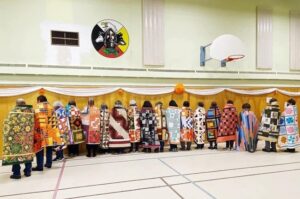Quilters provide warmth and comfort to Indian Residential School Survivors across Turtle Island

By Rick Garrick
TIMMINS — The Quilts for Survivors group in Timmins has created about 836 quilts for Indian Residential School Survivors and has requests for an additional 411 quilts as of Dec. 8.
“We’re making quilts and we’re giving them to survivors of residential school,” says Vanessa Grenier, founder and CEO at Quilts for Survivors and Missanabie Cree citizen. “We also honour Sixties Scoop survivors and Day School survivors, so we’ve been shipping [quilts] all across Canada and even into the United States.”
Grenier says she asked quilters in June to send her 216 quilt blocks in order to make 18 quilts.
“I said any pattern is acceptable — we have asked that they don’t use any travel, religious or school-related material just because we don’t want to re-traumatize anyone,” Grenier says. “We take 12 of [those blocks], sew them together and make a quilt top. Then we take batting and fabric for the back of the quilt, quilt it, and then we finish it and send it off to a survivor who has requested one, whether it was a loved one requesting it for them or them requesting it themselves.”
Grenier says there is a “great group of volunteers” in Timmins who help with the quilting.
“It’s a lot of fun and it’s really neat to see the different material that’s used in everyone’s interpretation of what we wanted,” Grenier says. “We use 12 of the blocks in one quilt. Each block is made by a different person, so there’s 12 people there, then you have someone who sews those blocks together, you could have two or three people doing that, then you have someone who puts all three pieces of the quilt together, then you have someone else who does the quilting, then you could have another person finishing, doing the closing up the quilt, it’s called binding, so you could have 15-20 people working on one quilt.”
Grenier says some of the survivors who have received quilts say the quilts are comforting and “like a warm hug.”
“Some people can’t believe that strangers would do this for them and for their fellow students, and they are just honoured to receive them,” Grenier says. “Most of the time, they can’t put into words how they feel. It’s very hard for some of them depending on where they are in their healing journey — it can be very difficult for them.”
Grenier says the volunteers find the work “very rewarding,” noting that they didn’t know about the history of the Indian Residential Schools and felt bad about what was done to the students.
“A lot of them were like: ‘This is what truth and reconciliation means,’” Grenier recounts. “We’re hearing the real truth and we’re able to support our fellow citizens in a tangible way, and they really like that part.”
Grenier says her current goal is to honour every request that comes in for quilts from residential school survivors.
“And then I’m also looking at making quilts for foster care children because there’s a lot of our people in foster care,” Grenier says. “I also think it would be nice to honour our sisters that are missing or murdered (and) some of our brothers, but I don’t think a quilt is an appropriate gift to give to their family so I was thinking more of a quilted wall hanging where they could possibly put a picture of their loved one in there because sometimes we just don’t know what happened to them.”
Information about the Quilts for Survivors group, which is registered as a not-for-profit, is posted online.


